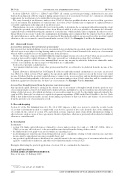Page 498 - SAIT Compendium 2016 Volume2
P. 498
IN 53 (2) Income Tax acT: InTeRPReTaTIon noTes IN 53 (2)
Sections 12B(4)(d), 12C(3)(c), 12DA(5) and 37B(5) all contain a provision preventing a deduction for any asset that has been disposed of by the taxpayer during any previous year of assessment. Section 11(e) contains an ownership requirement for an allowance to be deductible for income tax purposes.
The carry-forward of an allowance under section 23A(4) is therefore prohibited when an asset is sold in a previous year of assessment. The de nition of ‘rental income’ in section 23A(1) includes any recoupment of capital allowances or taxable capital gain on the disposal of an affected asset.
This inclusion can create a circular effect as it is not possible to determine the recoupment without knowing the extent to which the speci ed capital allowances have been allowed, while it is also not possible to determine the allowable capital allowances without knowing the amount of ‘rental income’ which includes any recoupment. In order to resolve this problem it is necessary to make the assumption in determining any recoupment that the taxpayer has been allowed all capital allowances on the affected asset in question. If this method results in an assessed loss after speci ed capital allowances, the excess must be carried forward under section 23A(4). See Examples 3 and 4 in the Annexure.
4.6 Assessed losses
Assessed loss arising in the current year of assessment
Any assessed loss incurred during a year of assessment (before deducting the speci ed capital allowances) from letting affected assets is not subject to ring-fencing under section 23A and is carried forward to the next year of assessment when it will be available for set-off against income from all sources.
On the other hand, a taxpayer will fall within the ring-fencing provisions of section 23A(2) when an assessed loss is created or increased by capital allowances. The term ‘assessed loss’ is de ned in section 20(2) as follows:
‘(2) For the purposes of this section ‘assessed loss’ means any amount by which the deductions admissible under section 11 exceeded the income in respect of which they are so admissible.’
Section 11(x) provides a deduction for –
‘any amounts which in terms of any other provision in this Part, are allowed to be deducted from the income of the taxpayer.’
Capital allowances fall under Part I of Chapter II of the Act and under normal circumstances can create an assessed loss. However, when section 23A(2) applies, the speci ed capital allowances may not exceed the lessor’s net rental income. It follows that the speci ed capital allowances cannot create an assessed loss and any disallowed amounts must be carried forward independently to the next year of assessment under section 23A(4) when they will be considered for deduction against net rental income for that year of assessment. See Example 5 in the Annexure.
Assessed loss brought forward from the previous year of assessment
Any speci ed capital allowances arising in the current year of assessment or brought forward from the previous year of assessment under section 23A(4) must rst be deducted from, and limited to, any net rental income derived from the letting of affected assets, after which any balance of assessed loss must be set off. See the similar approach taken by the court in CIR v Zamoyski* in relation to capital development expenditure (CDE) in the First Schedule to the Act. Such CDE is rst deducted from taxable income from farming operations for that year before any balance of assessed loss from the previous year of assessment is set off.
5. Record-keeping
Section 29 of the Tax Administration Act, No. 28 of 2011 imposes a duty on a person to retain the records, books of account or documents needed to comply with a tax Act for a period of ve years from the date of the submission of a return. In the context of section 23A and related sections, taxpayers must retain all the information relating to affected assets, such as copies of lease agreements, the date of purchase, allowances previously allowed and accumulated allowances carried forward.
6. Conclusion
In summary –
• section 23A limits capital allowances claimed by a lessor under sections 11(e) and (o), 12B, 12C, 12DA, 14bis or
37B(2)(a) on any ‘affected asset’ to the net rental income derived from the letting of those assets;
• the limitation does not apply to an asset let under an ‘operating lease’;
• in determining net rental income from letting affected assets, expenditure relating to both rental income and other
income must be apportioned on some reasonable basis; and
• any speci ed capital allowances disallowed are carried forward to the succeeding year of assessment when they will
again be considered for deduction, and subjected to limitation under section 23A(2). Examples illustrating the practical application of section 23A are contained in the Annexure.
Legal and Policy Division
SOUTH AFRICAN REVENUE SERVICE Date of 1st issue: 12 February 2010
* 1985 (3) SA 145 (C), 47 SATC 50.
490 saIT comPendIum oF Tax LegIsLaTIon VoLume 2


